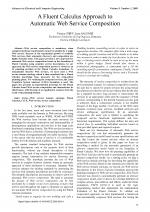| 3/2009 - 14 |
A Fluent Calculus Approach to Automatic Web Service CompositionCHIFU, V. |
| Extra paper information in |
| Click to see author's profile in |
| Download PDF |
Author keywords
web service domain ontology, fluent calculus, FLUX, web service, service composition
References keywords
composition(8), services(7), logic(7), thielscher(6), semantic(6), service(5), reasoning(5), programming(5), sirin(4), cicekli(4)
Blue keywords are present in both the references section and the paper title.
About this article
Date of Publication: 2009-10-26
Volume 9, Issue 3, Year 2009, On page(s): 75 - 83
ISSN: 1582-7445, e-ISSN: 1844-7600
Digital Object Identifier: 10.4316/AECE.2009.03014
Web of Science Accession Number: 000271872000014
SCOPUS ID: 77954763537
Abstract
Web service composition is mandatory when complex functional requirements cannot be satisfied by a single Web service. Because of the exponential growth of available Web services, their automatic discovery and composition are highly desirable tasks. This paper presents a new approach for automatic Web service composition based on the formalism of Fluent Calculus using semantic service descriptions. In our approach, the Web service composition process is viewed as an AI planning problem in the Fluent Calculus formalism. To semantically describe Web services, we have used a Web service domain ontology which is then translated into a Fluent Calculus knowledge base, necessary for the composition planning phase. For verifying the composed services, the Label Transition System Analyzer (LTSA) formalism is used. The paper also presents an experimental prototype for the Fluent Calculus based Web service composition and demonstrates its effectiveness with the help of an application scenario from the social event planning domain. |
| References | | | Cited By |
Web of Science® Times Cited: 3 [View]
View record in Web of Science® [View]
View Related Records® [View]
Updated 2 weeks, 6 days ago
SCOPUS® Times Cited: 5
View record in SCOPUS® [Free preview]
View citations in SCOPUS® [Free preview]
[1] Prediction of users webpage access behaviour using association rule mining, GEETHARAMANI, R, REVATHY, P, JACOB, SHOMONA G, Sadhana, ISSN 0256-2499, Issue 8, Volume 40, 2015.
Digital Object Identifier: 10.1007/s12046-015-0424-0 [CrossRef]
[2] Applying fluent calculus for automated and dynamic semantic web service composition, Bhuvaneswari, A., Karpagam, G. R., Proceedings of the 1st International Conference on Intelligent Semantic Web-Services and Applications, ISBN 9781450304757, 2010.
Digital Object Identifier: 10.1145/1874590.1874606 [CrossRef]
[3] Intelligent Composition of Dynamic-Cost Services in Service-Oriented Architectures, Ebrahim, Gamal A., 2011 UKSim 5th European Symposium on Computer Modeling and Simulation, ISBN 978-1-4673-0060-5, 2011.
Digital Object Identifier: 10.1109/EMS.2011.51 [CrossRef]
Disclaimer: All information displayed above was retrieved by using remote connections to respective databases. For the best user experience, we update all data by using background processes, and use caches in order to reduce the load on the servers we retrieve the information from. As we have no control on the availability of the database servers and sometimes the Internet connectivity may be affected, we do not guarantee the information is correct or complete. For the most accurate data, please always consult the database sites directly. Some external links require authentication or an institutional subscription.
Web of Science® is a registered trademark of Clarivate Analytics, Scopus® is a registered trademark of Elsevier B.V., other product names, company names, brand names, trademarks and logos are the property of their respective owners.
Faculty of Electrical Engineering and Computer Science
Stefan cel Mare University of Suceava, Romania
All rights reserved: Advances in Electrical and Computer Engineering is a registered trademark of the Stefan cel Mare University of Suceava. No part of this publication may be reproduced, stored in a retrieval system, photocopied, recorded or archived, without the written permission from the Editor. When authors submit their papers for publication, they agree that the copyright for their article be transferred to the Faculty of Electrical Engineering and Computer Science, Stefan cel Mare University of Suceava, Romania, if and only if the articles are accepted for publication. The copyright covers the exclusive rights to reproduce and distribute the article, including reprints and translations.
Permission for other use: The copyright owner's consent does not extend to copying for general distribution, for promotion, for creating new works, or for resale. Specific written permission must be obtained from the Editor for such copying. Direct linking to files hosted on this website is strictly prohibited.
Disclaimer: Whilst every effort is made by the publishers and editorial board to see that no inaccurate or misleading data, opinions or statements appear in this journal, they wish to make it clear that all information and opinions formulated in the articles, as well as linguistic accuracy, are the sole responsibility of the author.



